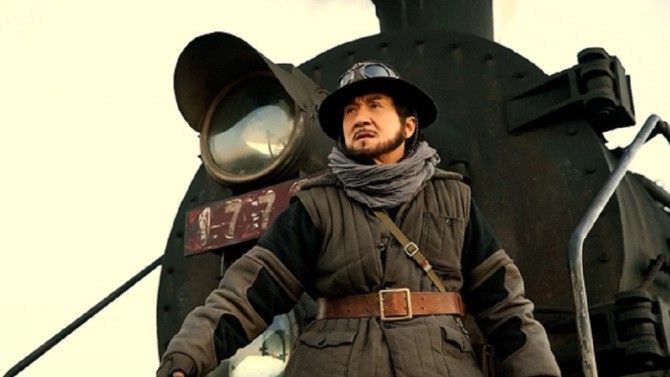Railroad Tigers (Ding Sheng, 2016)

January is the greatest movie month there is. Not only are we in the lesser metropolises of America finally granted access to tardiest of the previous year’s award hopefuls (see this week’s Silence), but via studio counter-programming logic, we also get Hollywood’s most interesting action films. The bloated prestige actioners get released in the summer (your Marvels and Nolans), while a handful of unstoppable forces stake their claim to winter break (the Star Warses and Camerons), while the suits and bean-counters push the films they don’t know how to exploit to the shadow of Oscar season. This is the month of Paul WS Anderson (his Resident Evil: The Final Chapter opens at the end of the month). It’s also blockbuster season in China, with big titles being released at Christmas-time and especially at Lunar New Year, which falls between the end of January and the end of February (it’s January 28 this year). Two years ago the big early January Chinese import was Tsui Hark’s The Taking of Tiger Mountain, last year it was Donnie Yen’s Ip Man 3. This year, we’ve got Railroad Tigers, opening this week at the Pacific Place.
Director Ding Sheng’s follow-up to his 2015 hit Saving Mr. Wu, it stars Jackie Chan as the head of a ragtag band of resistance fighters opposing the Japanese somewhere in China at some point in the middle of World War II. They live and work in a small railroad town, and are eventually tasked with the suicidal mission of blowing up a heavily-guarded bridge, a key supply route for the Japanese army. Divided into chapters and with animated, comic book-style character introductions (name, occupation, catchphrase) and with a lot of goofy, pre-teen comedy in-between the neck-snapping violence, the film is a fine example of the kind of tonal mishmash that so infuriates American screenwriting gurus. The comedy isn’t particularly funny, though, and despite the introductions (a style done with vastly more élan in Stephen Fung’s Tai Chi Zero), the ensemble all kind of runs together.
Jackie Chan stands out, of course, as much for the apparent phoniness of his beard and hair color (surely he’s gone gray by now?) as for his abilities as a martial arts performer, which are relegated to a few quick bursts here and there (and, given his advanced age and lifelong commitment to physical punishment, I can only say that comes as a relief: no one wants to see Jackie Chan break a hip on camera). There’s some meta-comedy with Jackie and his son Jaycee (reinstated in the movie industry after his 2014 arrest for possession of pot, for which he served time in prison and has made repeated public apologies), arguing over who has the handsomer nose. Blessedly breaking up the comic and character-building sequences are some bright bits of comic action, including a nicely constructed sequence where the band attempts to steal explosives for their mission. But it’s all a build up to the film’s final third, 45 minutes that stand with any action produced in 2016.
While director Ding overcuts to distraction in the film’s quieter moments (my wandering mind lost count at a dozen during a single minute of expository conversation), the concluding action sequence is quite solid, an escalating series of disasters that use a train as well as anything since Robert Aldrich’s Emperor of the North (I can’t go so far as to compare it to Buster Keaton’s The General, but it’s in the neighborhood), the poor commandos making their way up, through and under the various cars while fighting Japanese soldiers and tanks every step of the way. I’m mostly unfamiliar with Chan’s post-Handover work, and it’s weird to see him melt into the ensemble as he does here, to see the action not revolve around his athletic skills but rather the choreography of objects and machines as much as bodies in space. But Ding and his action director He Jun expertly build our understanding of the train and its geography, such that when it all begins to fall apart, there’s that sense of every piece of a puzzle sliding into place that we get from the greatest slapstick action sequences, from Laurel & Hardy to Sammo Hung. 2016 was a remarkably good year for trains in action movies, with the zombie hysterics of Train to Busan and the nigh-unbearable suspense of The Age of Shadows. Railroad Tigers isn’t in that class as a whole, but this final third gives the kind of silly thrill that so many recent Chinese imports (say, For a Few Bullets More to name a 2016 film with an unmemorable train sequence) have been lacking.
The movie is framed by a present-day story, with a field trip to a train museum where a child sees the logo of Chan’s resistance group and spies a burning coal, which then inspires the rest of the film, and apparently its comic style, the blend of goofy and gruesome that is particularly appealing to ten year olds. The Taking of Tiger Mountain had a similar frame, which similarly worked to modify the nature of the historical storytelling we were about to see on-screen. But where Tsui Hark used the frame to question the stories we tell about our past and the ways we tell them, the present-day sequence here is little more than an excuse for a superstar cameo in the film’s final moments (by an actor who specializes in superstar cameos in a film’s final moments). And that is the difference between a great movie set adrift in an unpromising season, and a what amounts to no more, or less, than a two hour respite from movies that try to be anything.
